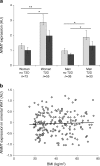Association of nicotinamide-N-methyltransferase mRNA expression in human adipose tissue and the plasma concentration of its product, 1-methylnicotinamide, with insulin resistance
- PMID: 25596852
- PMCID: PMC4351435
- DOI: 10.1007/s00125-014-3490-7
Association of nicotinamide-N-methyltransferase mRNA expression in human adipose tissue and the plasma concentration of its product, 1-methylnicotinamide, with insulin resistance
Abstract
Aims/hypothesis: Nicotinamide-N-methyltransferase (NNMT) was recently shown to be upregulated in mouse models of insulin resistance and obesity. So far, it is unknown whether NNMT is regulated in human disease. We have explored the hypothesis that white adipose tissue (WAT) NNMT expression and plasma 1-methylnicotinamide (MNA) concentration are increased in human insulin resistance and type 2 diabetes.
Methods: NNMT expression and plasma MNA were analysed in three groups of individuals: (1) 199 patients undergoing abdominal surgery; (2) 60 individuals on a 12-week exercise programme and (3) 55 patients on a two-step bariatric surgery programme.
Results: Patients with manifest type 2 diabetes have a significantly (approximately twofold) higher NNMT expression both in omental and subcutaneous WAT compared with controls. Notably, plasma MNA correlated significantly with WAT NNMT expression in patients with type 2 diabetes (women, r = 0.59, p < 0.001; men, r = 0.61, p < 0.001) but not in healthy control individuals. In insulin-resistant individuals, there was an inverse correlation between insulin sensitivity and plasma MNA (r = 0.44, p = 0.01) or adipose tissue NNMT mRNA (r = 0.64, p < 0.001). The latter association was confirmed in a second cohort (n = 60, r = 0.78, p < 0.001). Interventions improving insulin sensitivity--exercise and bariatric surgery--were associated with a significant (p < 0.001) reduction in WAT NNMT expression. Bariatric surgery was also associated with a significant decrease in plasma MNA.
Conclusions/interpretation: We demonstrate that WAT NNMT expression is regulated in human insulin resistance and type 2 diabetes and that plasma MNA correlates with increased tissue NNMT expression and the degree of insulin resistance, making it a potential biomarker for loss of insulin sensitivity.
Figures




Comment in
-
Management of nicotinamide N-methyltransferase overexpression: inhibit the enzyme or reduce nicotinamide intake? Reply to Zhou S, Li D, Zhou Y [letter].Diabetologia. 2015 Sep;58(9):2193-4. doi: 10.1007/s00125-015-3678-5. Epub 2015 Jun 26. Diabetologia. 2015. PMID: 26113421 No abstract available.
-
Management of nicotinamide N-methyltransferase overexpression: inhibit the enzyme or reduce nicotinamide intake?Diabetologia. 2015 Sep;58(9):2191-2. doi: 10.1007/s00125-015-3677-6. Epub 2015 Jun 30. Diabetologia. 2015. PMID: 26122878 No abstract available.
References
Publication types
MeSH terms
Substances
LinkOut - more resources
Full Text Sources
Other Literature Sources
Medical

